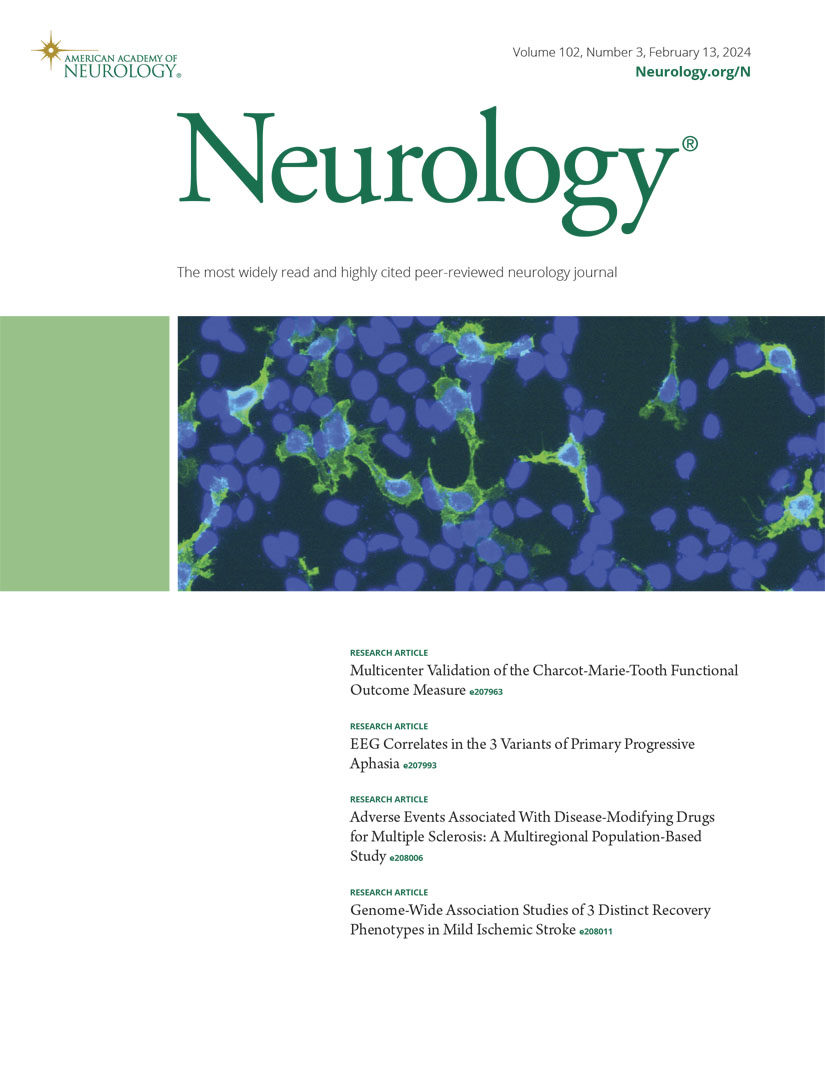血清α -亚麻酸与多发性硬化症的长期活动和进展。
IF 7.7
1区 医学
Q1 CLINICAL NEUROLOGY
引用次数: 0
摘要
背景和目的在一项前瞻性队列研究中,较高的饮食摄入α -亚麻酸(ALA)(一种植物源性omega-3多不饱和脂肪酸(PUFA))与多发性硬化症(MS)的风险降低相关,并且与患者队列中新病变、复发和残疾进展的风险降低相关。我们研究了血清ALA和其他PUFAs水平是否能预测临床发病后11年的MS预后。方法本前瞻性研究在BENEFIT临床试验的参与者中进行,从随机分组开始收集血清样本。用气相色谱法测定血清脂肪酸。我们使用Cox、负二项和线性回归评估了单个脂肪酸与临床确定多发性硬化症(CDMS)的时间和其他疾病活动性和进展指标的关系。结果随访468例,随访5年,其中278例随访至11年。基线时,中位年龄为30岁,71%为女性。较高的基线血清ALA水平与随访期间CDMS和复发的较低风险相关。5年和11年后,CDMS的多变量调整风险比分别为0.60 (95% CI 0.39-0.95)和0.60 (95% CI 0.37-0.98)。5年和11年后,多变量调整后的复发风险比分别为0.60 (95% CI 0.38-0.94)和0.65 (95% CI 0.43-0.99)。其他35种脂肪酸均与CDMS风险无关。3种脂肪酸与5年后复发率相关,但与11年后无关。较高的ALA水平与5岁时MS功能综合指数(残疾评估)下降较慢相关。在11岁时,这种关联是相似的,但结果没有保留统计学意义。基线ALA水平与随后认知功能的变化、确认扩展残疾状态量表进展的时间、新的活动性病变或脑容量损失无关。在一项大型前瞻性队列研究中,较高的血清ALA水平与较低的CDMS、复发和残疾进展风险相关。其他脂肪酸的结果无效或不一致。本文章由计算机程序翻译,如有差异,请以英文原文为准。
Serum Alpha-Linolenic Acid and Long-Term Multiple Sclerosis Activity and Progression.
BACKGROUND AND OBJECTIVES
Higher dietary intake of alpha-linolenic acid (ALA), a plant-derived omega-3 polyunsaturated fatty acid (PUFA), was associated with a lower risk of multiple sclerosis (MS) in a prospective cohort study and lower risk of new lesions, relapses, and disability progression in a patient cohort. We examined whether serum levels of ALA and other PUFAs predicted MS outcomes up to 11 years after clinical onset.
METHODS
This prospective study was conducted among participants in the BENEFIT clinical trial, who had serum samples collected starting at randomization. Serum fatty acids were measured using gas chromatography. We evaluated the association of individual fatty acids with time to clinically definite MS (CDMS) and other measures of disease activity and progression using Cox, negative binomial, and linear regression.
RESULTS
We followed 468 participants for 5 years, including 278 followed to year 11. At baseline, the median age was 30 years and 71% were women. Higher baseline serum ALA levels were associated with a lower risk of CDMS and relapses during follow-up. The multivariable-adjusted hazard ratios for CDMS comparing top to bottom quartile were 0.60 (95% CI 0.39-0.95) and 0.60 (95% CI 0.37-0.98) after 5 and 11 years, respectively. The multivariable adjusted risk ratios for relapses comparing top to bottom quartile were 0.60 (95% CI 0.38-0.94) and 0.65 (95% CI 0.43-0.99) after 5 and 11 years, respectively. None of the other 35 fatty acids were associated with CDMS risk. Three fatty acids were associated with relapse rate after 5 years, but not 11 years. Higher ALA levels were associated with a slower decline in MS Functional Composite, an assessment of disability, at 5 years. The association was similar at 11 years, but the results did not retain statistical significance. Baseline ALA levels were not associated with subsequent changes in cognitive function, time to confirmed Expanded Disability Status Scale progression, new active lesions, or brain volume loss.
DISCUSSSION
Higher serum ALA levels were associated with a lower risk of CDMS, relapses, and disability progression in a large prospective cohort. The results were null or inconsistent for other fatty acids.
求助全文
通过发布文献求助,成功后即可免费获取论文全文。
去求助
来源期刊

Neurology
医学-临床神经学
CiteScore
12.20
自引率
4.00%
发文量
1973
审稿时长
2-3 weeks
期刊介绍:
Neurology, the official journal of the American Academy of Neurology, aspires to be the premier peer-reviewed journal for clinical neurology research. Its mission is to publish exceptional peer-reviewed original research articles, editorials, and reviews to improve patient care, education, clinical research, and professionalism in neurology.
As the leading clinical neurology journal worldwide, Neurology targets physicians specializing in nervous system diseases and conditions. It aims to advance the field by presenting new basic and clinical research that influences neurological practice. The journal is a leading source of cutting-edge, peer-reviewed information for the neurology community worldwide. Editorial content includes Research, Clinical/Scientific Notes, Views, Historical Neurology, NeuroImages, Humanities, Letters, and position papers from the American Academy of Neurology. The online version is considered the definitive version, encompassing all available content.
Neurology is indexed in prestigious databases such as MEDLINE/PubMed, Embase, Scopus, Biological Abstracts®, PsycINFO®, Current Contents®, Web of Science®, CrossRef, and Google Scholar.
 求助内容:
求助内容: 应助结果提醒方式:
应助结果提醒方式:


